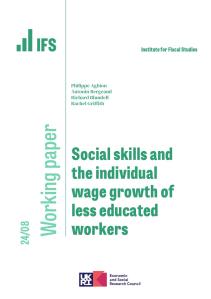On the same day that this observation was published the Secretary of State for Work and Pensions announced that the suspension of the Minimum Income Floor would be extended to the end of April 2021.
In the wake of the crisis, the government brought in two policies specifically targeted at shoring up the incomes of the self-employed: the Self-Employment Income Support Scheme (SEISS), and the suspension of the Minimum Income Floor (MIF) for self-employed claimants of Universal Credit (UC). The government announced, following the introduction of a second national lockdown, that the SEISS will be extended up until April. But on current plans the suspension of the MIF will end on Friday 13th November. These policies potentially affect a large number of people: before the crisis 14% of workers (4½ million) were self-employed, five in six of whom were ‘solo’ self-employed (i.e. without employees). This observation examines these two policies.
The Self-Employment Income Support Scheme
Self-employed workers are eligible for SEISS if self-employment represents more than half their taxable income, they made a tax return for 2018-19, and their profits in that year were under £50,000.[1] There have been two grants so far, with two more to come. For the first two grants, recipients had to state to HMRC that they had been ‘adversely affected’ by the crisis – though the magnitude of this adverse effect was not relevant for eligibility, and no proof was required. For the second two, the recipient must state that they have been impacted by ‘reduced demand’,[2] though again the magnitude of the demand fall is irrelevant and no proof is required. The first SEISS payment – which was available in mid-May – was equal to 80% of past profits (capped at £2,500 per month). The second (available in July) was set at 70% of past profits. There are two more payments now planned: one to cover November to January, set at 53%[3] of past profits, and another to cover February to April, the size of which is yet to be determined.
Because the extent of SEISS entitlement is not related to the amount of income an individual has lost, it is a relatively blunt tool for insuring workers against income losses. We find that – on average – among recipients of SEISS, the first payment fully replaced lost household income. But that reflects some recipients being less than fully compensated for losses, and others more than fully compensated. One in six claimants report experiencing no loss in pay between March and September.
Moreover, the financial eligibility criteria exclude many self-employed workers. We estimate that 18% of those for whom self-employment makes up at least half their income are ineligible for SEISS, while 38% of those with any self-employment income are ineligible. Among those who have not claimed SEISS, survey evidence indicates that two-thirds have seen a decline in income, and about a sixth were not working at all – suggesting that the eligibility criteria (as well as perhaps non-claiming by those eligible) screened out many people whose incomes had been affected by the crisis. The financial eligibility criteria for the next two SEISS payments has not changed, so there is likely to be a significant fraction of self-employed workers who see significant income losses as a result of the coming lockdown in England but receive little support. For those that are ineligible because they did not file a tax return in 2018-19 – perhaps because they only recently started their business – it is harder to see how the government could reach them to provide support. But the ineligibility of others – those who get less than half their income from self-employment, or who have profits over £50,000 – is a specific policy choice.
The timing of the payments is a critical issue. We find that during the two month or so wait between the beginning of the first lockdown and the first SEISS payment, future SEISS recipients reduced their spending by about 13% relative to similar households who had not seen any change in income, and the share making mortgage payments fell by a third. After they received the grant, however, spending fully recovered and mortgage payments largely did too. The next grant will be paid in early December,[4] meaning that those suffering reduced demand because of the new lockdown will have a month with lower income. This is shorter than the wait for the first grant, but nonetheless may be a difficult period for many recipients: for example some may have exhausted savings earlier this year. Looking ahead, there is case for doing six payments covering one month each, rather than two payments covering three. As well as ensuring a smoother stream of income for recipients, this would also be a better fit with the monthly assessment period for UC which matters as many low income self-employed people will be eligible for both SEISS and UC.
The Minimum Income Floor
Prior to the crisis, the MIF meant that self-employed claimants of UC were treated as earning the full-time minimum wage if they reported earning less (and so were eligible for less support than their reported earnings would suggest). There were exemptions for certain groups including lone parents with young children and those in the first year of self-employment.
The MIF can be interpreted as achieving several possible aims. First, it disincentivises self-employed claimants from (illegally) under-reporting their earnings in order to get a higher UC award (or lower tax liability). Second, because self-employed claimants are not – unlike unemployed claimants – required to search for additional work, the MIF disincentivises individuals from claiming UC as a self-employed worker with low or zero earnings to avoid job-search requirements. Third, it avoids the government subsidising low-earning or non-viable self-employment when the worker could instead get a higher paying employee job.[5]
Following lockdown in the spring, job-search requirements were suspended for other UC claimants, and – with many businesses forced to close – there were very few employee vacancies. These factors substantially weakened the purpose of the MIF, and for these good reasons it was temporarily suspended.
On current plans the MIF will be reinstated on Friday 13th November. But just as the first lockdown rather undercut much of the rationale of the MIF, it seems like the second will do so in the same way. Presumably few employers will be looking to hire employees over the next month or so, making job search a futile exercise for many, and meaning that plenty of low income self-employed workers will not have the option of starting an employee job at higher pay.
The government’s choices here are important. Before the pandemic, around 450,000 households were affected by the MIF, which reduced their average benefit entitlement by £3,200 per year each.[6] Moreover, some workers affected by the MIF might find themselves better off if they give up work altogether: if they are simply treated as being unemployed, they are not subject to the MIF and so get higher UC payments. If work search requirements are also suspended then this would not even – at least for a while – require them to engage in greater activities.
Beyond the current situation, the government should take this opportunity to think about the long-run design of the MIF. While a form of MIF is almost certainly sensible, in its current form it penalises those with fluctuating incomes, something much more common among the self-employed than employees, and (as described here) this aspect of the policy could be fixed. But in the immediate future it is difficult to see why the justification for suspending the MIF back in March should not apply again in November.
We are thankful for funding from the Economic and Social Research Council (ESRC), as part of UK Research and Innovation’s rapid response to COVID-19, grant number ES/V00381X/1.
[1] The conditions are in fact slightly more complicated than this but we omit those complications here for brevity.
[2] This is a narrower condition than the ‘adversely affected’ one that governed the first two payments. For example, someone who is unable to work because they are shielding would be eligible for the first two payments, but not the second two.
[3] Specifically, recipients are entitled to 80% of past profits for November, and 40% for each of December and January. That means that the payment covering these three months will be equal to 53.3% of past profits. The government have rounded this to 55% in some of their statements on the subject.
[4] The government have announced that applicants will be able to make claims from 30th November. The gap between application and payment for the first grant appeared to be about five days (with the application window opening on 13th May and the first payments on the 18th), so the next grant will probably be received in early December.
[5] Further discussion of the MIF is available in the 2020 Green Budget.
[6] These figures assume full take-up of UC. Some of these households will still have been on pre-UC ‘legacy’ benefits, or not claiming any benefits.









